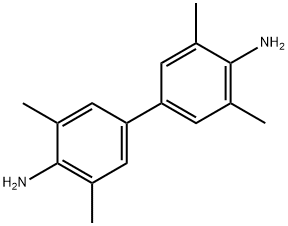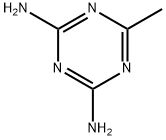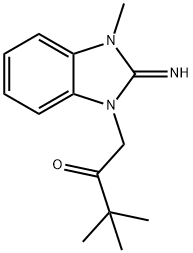Tetramethylguanidine
Synonym(s):N,N,N′,N′-Tetramethylguanidine;1,1,3,3-Tetramethylguanidine;N,N,N′,N′-Tetramethylguanidine
- CAS NO.:80-70-6
- Empirical Formula: C5H13N3
- Molecular Weight: 115.18
- MDL number: MFCD00008323
- EINECS: 201-302-7
- SAFETY DATA SHEET (SDS)
- Update Date: 2025-04-29 15:35:11

What is Tetramethylguanidine?
Chemical properties
N,N,N',N' -Tetramethylguanidine (TMG) [80-70-6], C5H13N3, Mr 115.18, is a stable, unusually strong base, pKa 13.6 (25 ℃), with a free imino group. It is a colorless to light-yellow liquid, miscible with water and common organic solvents: 0.92 g/cm3 (25 ℃), bp 160 ℃, vapor pressure 0.03 kPa (25℃).
The Uses of Tetramethylguanidine
Tetramethylguanidine (TMG) is used as polyurethane foam catalyst, as accelerator for the syntheses of polysulfured rubber, as a strong base in the photochemical (e.g. couplers) and in the pharmaceutical (e.g. steroids) industries. Product Data Sheet
The Uses of Tetramethylguanidine
Base employed in the preparation of alkyl nitriles from alkyl halides and 3′-alkylthymidines from 3′-nitrothymidines.
The Uses of Tetramethylguanidine
1,1,3,3-Tetaramethylguanidine is used as a strong, non-nucleophilic base for alkylations in organic synthesis. 1,1,3,3-Tetramethylguanidine is an efficient and selective catalyst for the benzoylation of alcohols.
Flammability and Explosibility
Flammable
Synthesis
Prepared from cyanogen chloride and dimethylamine in a 1 : 2 molar ratio, TMG is used as a polyurethane foam catalyst, in the preparation of pigments for color photography, and in steroid synthesis.
Purification Methods
Reflux it over granulated BaO, then fractionally distil it. Protect it from CO2. [Beilstein 4 IV 227.]
Properties of Tetramethylguanidine
| Melting point: | -30 °C |
| Boiling point: | 162-163 °C (lit.) |
| Density | 0.916 g/mL at 20 °C (lit.) |
| vapor pressure | 0.2 mm Hg ( 20 °C) |
| refractive index | n |
| Flash point: | 140 °F |
| storage temp. | Store below +30°C. |
| solubility | Acetonitrile (Slightly), DMSO (Slightly), Methanol (Slightly) |
| pka | 15.20±0.70(Predicted) |
| form | Liquid |
| color | APHA: ≤150 |
| Odor | mild ammoniacal odor |
| PH | 12.7 (10g/l, H2O, 25℃) |
| Relative polarity | 5.5 |
| explosive limit | 1.0-7.5%(V) |
| Water Solubility | miscible |
| Sensitive | Air Sensitive |
| BRN | 969608 |
| Dielectric constant | 23.100000000000001 |
| Stability: | Stable. Combustible. Incompatible with strong oxidizing agents, mineral and organic acids, carbon dioxide. Air-sensitive. |
| CAS DataBase Reference | 80-70-6(CAS DataBase Reference) |
| NIST Chemistry Reference | N,N,N',N'-Tetramethylguanidine(80-70-6) |
| EPA Substance Registry System | Guanidine, N,N,N',N'-tetramethyl- (80-70-6) |
Safety information for Tetramethylguanidine
| Signal word | Danger |
| Pictogram(s) |
 Flame Flammables GHS02  Corrosion Corrosives GHS05  Exclamation Mark Irritant GHS07 |
| GHS Hazard Statements |
H226:Flammable liquids H290:Corrosive to Metals H302:Acute toxicity,oral H314:Skin corrosion/irritation |
| Precautionary Statement Codes |
P210:Keep away from heat/sparks/open flames/hot surfaces. — No smoking. P233:Keep container tightly closed. P280:Wear protective gloves/protective clothing/eye protection/face protection. P301+P312:IF SWALLOWED: call a POISON CENTER or doctor/physician IF you feel unwell. P303+P361+P353:IF ON SKIN (or hair): Remove/Take off Immediately all contaminated clothing. Rinse SKIN with water/shower. P305+P351+P338:IF IN EYES: Rinse cautiously with water for several minutes. Remove contact lenses, if present and easy to do. Continuerinsing. |
Computed Descriptors for Tetramethylguanidine
| InChIKey | KYVBNYUBXIEUFW-UHFFFAOYSA-N |
Tetramethylguanidine manufacturer
New Products
4,4-Difluoropiperidine hydrochloride tert-butyl 9-methoxy-3-azaspiro[5.5]undecane-3-carboxylate Indole Methyl Resin N-Isopropylurea N,N-Dicyclohexylcarbodiimide(DCC) MELDRUMS ACID 5-METHYLISOXAZOLE-4-CARBOXYLIC ACID Magnessium Bis glycinate Zinc ascorbate 1-bromo-2-butyne 2-acetamidophenol 9(10H)-anthracenone Erythrosin B, 4-Piperidinopiperidine 2-((4-morpholinophenylamino) (methylthio) methylene) malononitrile 2,4-dihydroxybenzaldehyde 3-(4-morpholinophenylamino)-5-amino-1H-pyrazole-4-carbonitrile Methyl 2-methylquinoline-6-carboxylate 2,6-dichloro-4-nitropyridine 4-Bromo-2-chlorobenzonitrile 2-(benzylamino)acetic acid hydrochloride 4-(tert-Butoxycarbonylamino)but- 2-ynoic acid 3,4-dihydro-2H-benzo[b][1,4]dioxepine 1-Phenyl-1-cycloprppanecarboxylicacidRelated products of tetrahydrofuran





![9-(2-CHLOROETHYL)-2,9-DIHYDRO-3H-IMIDAZO[1,2-A]BENZIMIDAZOLE](https://img.chemicalbook.in/StructureFile/ChemBookStructure3/GIF/CB0448271.gif)

![4-(2-(4-[3-CHLORO-5-(TRIFLUOROMETHYL)-2-PYRIDINYL]PIPERAZINO)-4,5-DIHYDRO-1H-IMIDAZOL-1-YL)BENZENECARBOXYLIC ACID](https://img.chemicalbook.in/StructureFile/ChemBookStructure3/GIF/CB4683007.gif)
You may like
-
 80-70-6 1,1,3,3-Tetramethylguanidine 98%View Details
80-70-6 1,1,3,3-Tetramethylguanidine 98%View Details
80-70-6 -
 1,1,3,3-Tetramethyl guanidine 99%View Details
1,1,3,3-Tetramethyl guanidine 99%View Details
80-70-6 -
 80-70-6 99%View Details
80-70-6 99%View Details
80-70-6 -
 1,1,3,3-Tetramethyl guanidine CAS 80-70-6View Details
1,1,3,3-Tetramethyl guanidine CAS 80-70-6View Details
80-70-6 -
 1,1,3,3-Tetramethylguanidine CAS 80-70-6View Details
1,1,3,3-Tetramethylguanidine CAS 80-70-6View Details
80-70-6 -
 1,1,3,3-Tetramethylguanidine CAS 80-70-6View Details
1,1,3,3-Tetramethylguanidine CAS 80-70-6View Details
80-70-6 -
 N,N,N′,N′-Tetramethylguanidine CAS 80-70-6View Details
N,N,N′,N′-Tetramethylguanidine CAS 80-70-6View Details
80-70-6 -
 N,N,N′,N′-Tetramethylguanidine CAS 80-70-6View Details
N,N,N′,N′-Tetramethylguanidine CAS 80-70-6View Details
80-70-6
